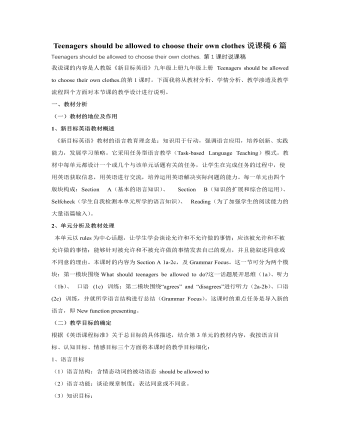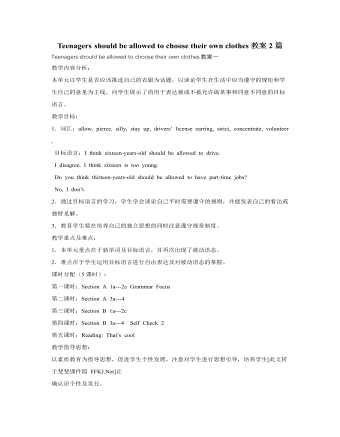人教版新目标初中英语九年级上册I used to be afraid of the dark说课稿4篇
-
- 页数:22页
- 字数:约 22271 字
- 大小:344.00KB
- 格式:.doc
- 版本:Office2016及以上版本
- 作者:DJW
I used to be afraid of the dark说课稿4篇
I used to be afraidof the dark. Section A说课稿
尊敬的各位评委老师:
大家上午好!我是来()学校的(),今天我说课的内容是新课标英语九年级第二单元Section A,题目为:I used to be afraid of the dark.本单元具有三部分,Section A, SectionB和自我检测部分。我计划用四课时完成,本节课是第一课时,从教材的整体上来说,本节课仍在进行一般过去时的学习,并且进行了一般过去时和一般现在时的综合运用。

再有从本单元来说,它既是本单元基本语言内容,又为本单元知识的扩展和综合语言运用奠定坚实基础。因此上好Section A部分即可以让知识学习有一定的延续性,又可为下面的教学做好铺垫,对完成本单元和今后的英语教学具有重要的意义。基于以上分析,本节课的教学要达到以下几个目标:在知识与能力方面,让学生掌握used to do结构,学会用英语运用本结构谈论自己和他人过去经常做的事,学会谈论自己和他人过去的外貌、性格和爱好。学会谈论自己和他人的变化等等,从而提高学生的语言综合运用能力;在过程与方法方面,指导学生在自主探究和任务型教学模式中,主动参与学习活动和积极与他人配合。
在情感目标方面,采用积极的手段去激发学生的学习兴趣,让学生充满自信,体验成功感和具有合作精神。而且通过目标语言的学习使学生在学习和生活中能发现问题,不断进步。使学生更加了解自己和树立自信心,明确自己的奋斗目标。
对于Section A部分教学,我准备把used to do和but的用法作为重点,把一般过去时和一般现在时的比较作为难点。
为达到以上教学目标,突出重点,突破难点,根据英语课程的要求,知识的讲授要从学生的学习兴趣、生活经验和认知水平出发去发展学生的综合语言的运用能力,提高跨文化意识和形成自主学习的能力。因此,我将在教学中采用任务型教学模式,利用多媒体辅助教学、结合听说法、竞赛法,以循序渐进的方式来进行教学。根据初中生的抽象思维能力还不太高,注意力还很分散的特点,在课堂教学的每个环节中,我将采用多媒体辅助教学,利用多媒体展示学生们喜欢的图片,以增强学生的兴趣和注意力,因为教育心理学给了我们这样的提示:如果学生对于一件事物有极大的兴趣,他们会就排除主观和客观的消极因素,尽量全身心地投入到知识的学习中去。
教法的选择固然重要,但学法也是不可缺少的。我们都知道学生的学习并不仅仅孤限于课堂的学习之中,很多时候更需要参于实践,因此,我们应遵循学生的这一身心发展规律和学习规律,在教学过程中,利用合作与交流的学习方式指导学生去体验、实践、参与去提高他们的各种能力。在本节课的教学中,我主要采用比较法和小组合作学习的方法。
教法与学法的选择是为了更好地服务于课堂,在课堂教学中我设计了如下八个环节:
Step 1: 课前热身,首先用多媒体播放歌曲《Yesterday once more》,让大家一起跟唱,在课前营造轻松愉快的氛围,然后通过大屏幕显示图片,进行师生互动和生生互动。通过几组图片对人物的外貌和性格进行描述,去复习形容词,为目标语言的学习作铺垫。这些图片都是同学们所喜欢的,会使学生产生浓厚的兴趣,主动思维。而且这一环节中为学生提供了说英语的机会,营造了说英语的氛围。
Step 2: 激趣导入,在本活动中通过听说法配合多媒体辅助教学导入新课,引出used to do结构。并以其为引线,不知不觉地将学生引入新课,达到润物无声的效果。
Step 3: 小组竞赛。本活动采用任务型教学模式及小组合作的学习方式,办法是以小组为单位,学生们手拿旧照片,用目标语言对过去的情况分别进行介绍,最后各组组长,代表本组运用She used to be short, didnt she? She used to play basketball, didnt she?的句型进行汇报。开展此项活动可以培养学生的合作精神和竞争意识。同时,可以训练学生快速思维的能力及语言表达能力。
Step 4: 比较交流
这一方法主要用于任务型教学及work in pairs的对话时刻,谈论自己和搭档在过去和现在情况,巩固used to do结构与but的用法。同时区别两种不同时态的运用。通过练习培养学生的语言表达能力,突破本课的难点。体现“用中学,学了就用”的教学理念。在这一环节中落实情感目标,让学生认识自己的不足,明确自己的奋斗目标,在生活和学习中互相帮助,相互学习,取长补短。
Stetp 5: 听力反馈
这个环节我设计了两个听力练习。
练习一:利用1b的内容填空。
练习二:利用2a和2b完成used to do的训练及but的运用。
通过这一环节,使学生能更进一步对声音语言进行体会、感受,提高学生听的能力,也来检验一下本节课重点知识的掌握情况。
Step 6: 综合运用
猜谜游戏,四人一组,对班上的老师或同学进行过去和现在的对比介绍,猜其是谁,在组织语言的过程中,每人一句,合作探究完成任务。在写作的过程中增强合作意识和提高写作水平。在猜测的过程中,去提高学生的听说水平,调动他们的积极性,感受英语学习的快乐与成功。帮助他们树立学习英语的自信心。
要想让学生正确的使用语言结构“used to do”及过去与现在的时态,形成完整统一。让学生自己通过上述的游戏活动和利用板书设计明确本节课的重难点。在这一环节中,我将采用对比法,意在培养学生的自主探究能力、观察能力和归纳能力。
Step 7: 自我评价
在这一环节中,为了检测学生对于used to do语言结构的掌握完成作文(大屏幕)。在这个过程中我采用男女擂台赛:用大屏幕呈现几组对比图片。限定五分钟内,独立完成写作。写作结束后以最快的速度张贴在黑板上。看男生和女生哪组作文写得又多又好,多而好的那一组为胜利组。在擂台赛过程中,学生会努力思维,充分运用所学语言,积极地完成任务,为本组争光。这个过程一定会激发学生的学习兴趣和强烈的写作欲望,增强学习的责任感体会到学习的重要性。从而使学生综合运用语言的能力得以提高。
Step 8: 布置作业
《英语课程标准》建议教师把“任务型”教学活动延伸到教学之外的学习和生活之中。为此,我把作业布置为常规性作业和探究性作业两种。
常规性作业:完成《学英语》上的练习。
探究性作业:比较自己学习方法的转变。
探究性作业既是本节课的新任务,也是下节课的前任务。
以上就是这次我说课的内容,如有不足之处,请各位领导评委给与指导,谢谢大家!
I used to be afraidof the dark. Section A 第二课时说课稿
今天我说课的内容是九年级Unit2 I used to be afraid of the dark.. Section A的第二课时。
一、说教材
(一)教材的作用及地位
《新目标英语》教材采用“话题 .功能.结构”三维的编排形式,凸现了语义、语言结构和语用三者有机结合的“任务型语言教学(Task - based Language Teaching & Learning)”的现代英语教育理念和教学途径。这种十分突出的编排特点,使得英语教和学的过程始终以“话题”为主线,交际功能的实践围绕着话题展开,语言结构的学习和掌握融入综合的语言运用活动之中。
本单元以 “how we have changed” 为核心话题,编排了一系列凸现“交际功能(talk about what they used to be like)”运用的听说读写综合语言活动。在这些语言活动中,融入大量含语言结构(used to)的学生可接受的语句。然后,在学生感受、理解、体验的基础上,学习该结构。这种三维的设计,形成了一个循序渐进、自然的学习程序。
本节课是section A 的第二课时,在第一课时我们学习了如何谈论自己的外貌、性格
及娱乐方面的变化,本节课我们首先复习第一课时的内容然后学习使用be afraid of 这一结构来继续谈论过去于现在的变化。
(二)教学目标
根据《英语课程标准》关于总目标的具体描述,结合本节课的教学内容,我制订了如下目标:
1、知识与技能目标:学会使用be afraid of,并能结合used to 结构谈论自己及他人的过去与现在的变化。
2、过程与方法目标:通过直观的对图片的感受谈论自己的变化,通过听力及对话来了解别人的变化,通过小组调查这样的任务型活动来谈论他人的变化。
3、情感目标:人是发展变化的,不但身体上会发生变化,兴趣和爱好也会较以前有所不同,随着年龄的增长,应不断克服自己的缺点,增长知识,健全自己的人格,日趋完善自己。
(三)教学重点及难点
用be afraid of 来谈论自己及他人过去于现在的变化。
二、教学设计的理念及思路
八年级的学生对英语语言知识有了一定的积累,而且本单元涉及的外貌及性格在七年级下册第七单元已经学习过,学生表达上会比较容易,能够体会到成就感。可以借此提高他们对英语学习的兴趣并培养口语表达能力。
按照课程标准的要求八年级结束时学生应在听说读写方面要达到四级标准,所以教学设计时要注意语言能力的培养与积累。首先采用直观教学法复习第一课时的内容,并利用直观教学法学习使用be afraid of 来谈论自己的变化,通过听力来了解其他人的变化,采用任务型教学法来输出语言,从而培养学生的自主学习能力。
三、教学过程的安排与意图
1、Warm-up
Task1 通过用used to 和now 来描述不同图片中人们的性格外貌及娱乐方面的变化。通过这样的直观教学使学生更加记忆深刻,达到复习的目的。
2. Lead-in
Task 2 通过看图片来描述自己对图片的感觉来学习使用 be afraid of 并用此句型谈论自己过去和现在的变化。看到图片感受更加明显,有利于理解记忆。
3、Listening
根据本节课的教学目标自编了一个听力练习,通过听力练习再现情境,使学生了解何时可以应用到本节课的教学内容。并了解其他人过去与现在对一些事物的情感变化。
Task 3 pair work,让学生模仿simple conversation来询问彼此过去与现在对事物的情感及变化
Task 4 survey time 四人一组,调查除自己以外的组员对书中3a所列事物害怕与否及现在的变化。然后由一名同学做出报告。由此可以掌握学生对所学内容的掌握情况。
4、Homework 调查家人曾经是否有害怕的事物,现在是否有变化。完成表格并写出报告。此项作业可以使学生真正的应用到所学知识,并更加了解家人,理解家人了解人都是发展变化的,随着年龄的增长,我们应不断克服自己的缺点,增长知识,健全自己的人格,日趋完善自己。
以上就是我本节课内容的教学设计及分析。
I used to be afraidof the dark. Period one说课稿
I. Analysis of theTeaching Material
This unit is aiming at talking about whatthe people used to be like with the pattern of used to be, used to have, usedto like. All the activities are carried out around the topic of how to describethe peoples appearance and personality. The first teaching period serves as anintroduction and lead-in part. During this part the goal was introduced and themain topic of this unit also was presented. Just like a warming up it plays, itis acceptable to review what has been learned in the last unit and to transferto the new language. The materials in talking are mostly from the recent reallife and are familiar to the students. A series of questions with pictures anda big picture are used to attract students to the knowledge.
Ⅱ. Analysis of the Students
As Junior 3 students,they would like to talk about the changes between a person in the past and now.They have learned some words about how to describe the peoples appearance andpersonality like short, tall, long hair, short hair, kind, friendly, serious,shy and so on. So it is easy for the students to listen about, talk about orwrite about what the people used to be like. Such topic will remind students ofthe days of their childhood. So it is also helpful to raise learning interestof students and students will be active in all the activities in this unit.
Ⅲ. Overview of Lesson Plan
The first periodintroduces a lot of words describing people first. And then students will beprovided listening and oral practice using the target language. So in thislesson, students will learn how to describe the peoples appearance andpersonality. They will share opinions about the changes between a person in thepast and now by comparing, listening and talking.
IV. Objectives
1. KnowledgeObjectives
Students willlearn to talk about what they used to be like and they will learn and grasp thestructure used to, including statements, yes / no questions and short answers.
2. AbilityObjectives
Students willtrain their own integrating skills by comparing, brainstorming, listening,talking, reading and writing.
3. Moral Objectives
Students will knowthat everyone surely changes. If someone is afraid of speaking in front of theclass, encourage her/him not to be shy. "More practice, and youll feelmore confident."
V. Teaching KeyPoints
1. To learn thekey vocabulary and the target language
a. Key vocabulary:outgoing, friendly, serious, quiet, curly hair, straight hair
b. Targetlanguage: I use to be quiet. / She used to have long hair./...
2. To learn theusage of the structure used to.
--- You used to beshort, didnt you? --- Yes, I did. / No,I didnt. He is tall.
--- Did Tony useto play the piano?--- Yes, he did. / No, he didnt.
They didnt use tolike tests.
VI. TeachingDifficult Points
1. To improve students listening, speaking skills.
2. To enablestudents to grasp the usage of the structure used to.
VII. Resources
1. A taperecorder.
2. Some posters.
3. Some photos.
VIII. TeachingTime
45 minutes.
Ⅸ. Procedures
Step 1. Pre–listening
This activity willintroduce a lot of words describing people first. And then students areprovided listening and oral practice using the target language.
--- Mario used tobe short.--- Yes, he did. Now, hes tall.
1. Warm-up (1a)
Show some postersto the students and introduce the key vocabulary. Let them describe thepeoples appearance and personality by comparing and brainstorming .Call theirattention to the chart with the headlines.
Appearance: tall,short, long hair, short hair,good-looking, thin, strong, ...
Personality: outgoing,funny, quiet, shy, friendly, kind, warm-hearted
a. Look at thepictures and describe the appearance.

b. How can wedescribe the personality?

2. Presentation
Show students somephotos in the past and now. Let students compare and practice to understand thetarget language "used to be" in spoken conversations.

3. Explanation
When we talk aboutthe things that have changed, we can use "used to".
e.g. Tom used tobe short. Now he is tall.
She used to have short hair. Now she has longhair.
Mary used to like eating meat. Now she likeseating vegetables.
Step 2.While-listening
The activity willgive students practice in understanding the target language in spokenconversation.
1. First listening
Bob is seeing somefriends for the first time in four years. What did his friends use to looklike?
a. Play therecorder and let the students listen and fill in the chart. (1b)
1. Mary usedto short .He used to wear _glasses_ .
2. Amy used to be_tall . She used to have _short hair .
3. Tina used tohave _red and _curly hair .
b. Pairwork
1. Let students have some more practice. Thestudents look at the chart and make conversations in pairs. (1c)
2. Secondlistening
Play the recorderand let the students listen and check the words they hear. (2a)
3. Third listening
Play the recorderagain and let the students listen and fill in the blanks with the words theyhear. (2b)
Paula: Hey, Steve!Over here! Dont you remember me?
Steve: Oh, wow!Youre Paula , arent you?
Paula: Thatsright.
Steve: But youused to be really __quiet ,didnt you?
Paula: Yeah. Iwasnt very outgoing .
Steve: No, youwerent. But you were always friendly . Wait a minute! Did you use to play thepiano?
Paula: Yes, I did.But now Im more interested in sports. I play soccer and Im on the swim team.
Steve: Wow! Peoplesure change.
Name
Sep.18, 2008
Sep .18, 2000
Yang Lan
tall
short
Mary
long hair
short hair
Mrs. Liu
serious
funny
_______shy
_______serious
√friendly
_______funny
__√___outgoing
√ quiet
Step 3.Post-listening
This activity ishelpful to improve students speaking skills.In this activity, we will introduce more words to students to extend theirvocabulary and we will provide more oral practice to them using both the oldand new target language. They make conversations about peoples appearance andpersonality, and they can also talk about the peoples hobbies.
1. Pairwork (2c)
Tell the studentsto practice the conversation in activity 2b. Then make conversations aboutthemselves in pairs. They can use...
A: Hello! YoureZhu Guoming, arent you?
B: Yes, youreright.
A: But you used tobe really quiet, didnt you?
B: Yeah. I wasntvery outgoing.
A: No, you werent. But you were alwaysfriendly. Wait a minute! Did you use to play the piano?
B: Yes, I did. But now Im more interested insports. I play soccer and Im on the swim team.
A: Wow! Peoplesure change....
2. Talk abouttheir photos in pairs
Before class, leteach student prepare two photos. One was taken in the past, and one is takennow. Now, let them take out their own photos and make conversations about theirchanges in pairs by comparing the two photos. Then ask some pairs to act theirconversations out in front of the class. In this activity, students willpractice the target language by listening and speaking. Encourage her/him notto be shy. "More practice, and youll feel more confident." Help tobuild the students confidence.
3. Guessing games
In this activity,students will use the target language to get more detailed information of theirclassmates. Students are fond of such activities. So they are helpful toimprove students spoken English.From the game, let students find out the usages of used to and then summarizethe usages of used to.
a. First theteacher plays the guessing game with the whole class as a modal. Saying "Canyou guess what I used to be like?" Let students guess.
Student 1: Did youuse to be thin?
Teacher: Yes,youre right. I used to be thin, but now Im heavy.
Student 2: Did youuse to have short hair?
Teacher: No, Iused to have long hair.
Student 3: Did youuse to like running?
Teacher: Yes, Iused to like running, but now I have no time to run.
...
b. Ask three orfour students to come to the front of the class and play the game with thewhole class. Teacher will give them some help if they need.
Step 4. Summary
This activity willhelp students to summarize the usages of used to.As students say, teacher willwrite them on the blackboard.Students can say in Chinese.
Teacher: What havewe learned today?
Student A: Todaywe have learned the statement of the usages of used to.
e.g. ---You usedto be short, didnt you?--- Yes, I did. / No, I didnt.
Student B: And we have also learned theyes/no questions and short answers of the usages of used to.
e.g. --- DidTony use to play the piano? --- Yes, hedid. / No, he didnt.
Student C: And we have also learned thenegative sentences of the usages of used to.
e.g.They didntuse to like tests.
Step 5. Homework
This activity willhelp students to consolidate the target language we have learned today. From students homework, teacher will find out that whatthe students have mastered and what they havent mastered and decide what willdo in the future teaching.
I used to be afraid of the dark.
Appearance: tall, short, long hair, short hair,good-looking...
Personality: outgoing, funny, quiet, shy, friendly, kind, warm-hearted
Grammar Focus:
--- You used to be short, didnt you? --- Yes, I did. / No, I didnt.
--- Did Tony use to play the piano? --- Yes, he did. / No, he didnt.
She used to be really quiet.
They didnt use to like tests.
He used to have long hair.
I used to be afraidof the dark.说课稿
我说课的内容为初三英语上册I used to be afraid of the dark. 整个说课包括教材分析、教材处理、说教法、说学法、课时划分和教学过程六大板块。
一、教材分析
1.教材的地位及作用:
本单元是初中英语新教材第三册第2单元,本单元的核心话题为“talk about what they used to be like”,围绕着谈论过去自己和他人过去经常做的事,谈论自己和他人过去的外貌性格爱好,以观察图片、听力理解、阅读理解等训练方式和独立学习、合作交流、完成任务等形式完成目标语言的输入,学习句型Used to 为主要学习任务,并且设置任务型综合性语言实践活动,让学生在交际活动中,学会如何正确地用英语表达自己的意见和建议,重在培养学生的习得语言运用能力、实践能力、合作能力及创新意识。
2.教学目标
(1)知识目标
重点词汇●Used to, dark, spider, insect
●Used to
●Conjunction but
重点句型●Mario used to be short.
● Yes, he did. Now he’s tall
●I used to eat candy all the time.
● Did you ?
●Yes, I did. And I used to chew gum a lot.
(2)能力目标
1)依托本单元的语言素材提高学生听、说、读、写及自学、创新和沟通能力。熟练掌握“used to”句型,培养学生运用语言的能力。
2)培养学生善于听说、乐于听说的良好习惯和学习能力。
3)运用CAI或图片,充分调动学生的感官,培养观察力和注意力。
4) 在表演中培养学生乐于表达的人际交往能力和知识创新能力。
(3)、重点和难点
重点: used to句型。
难点:used to句型在日常生活中的运用。
确立重点与难点的依据:
根据教学大纲的要求,及本单元在教材中所处的地位和作用。
二、教材处理:
根据以上对教材的分析,同时针对学生学习外语存在一定困难的实际情况。首先给学生创造外语语言氛围,创设一定的语言情景,这样可以激发学生学习兴趣,使学生在参与一系列活动中,掌握知识。最后通过对话和小组活动对学生所学知识点进行训练,从而达到巩固知识的目的。
三、说教法:
教学内容的核心要求符合科学规律、认识规律,因此我在教学过程中,正确把握教育教学的特点,倡导自主、合作、探究的学习方式,激发兴趣,调动思维,培养创新能力,力求简练、正确、系统。通过五步教学法,精讲巧练,由浅入深,由易到难,由已知到未知,循序渐进地深化教学内容。展开以教师为主导,以学生为主体的师生双边活动。采用视听法、问答法,和情景交际法,并把竞争机制引入课堂。
(1) 视听法,主要通过多媒体课件展示、图片展示、老师提问、学生回答等方式提供让学生看、听、说、的练习机会
(2) 问答法和情景交际法,用多媒体展示各种图片,让学生利用这些图片进行交流,让学生在做中学,在实践中获得信息,习得英语。
对教材的处理上本着,以“旧”代“新”,以“练”促“学”,以“熟”生“巧”的原则,通过朗读、背诵、对话和小组表演,提高口语表达能力,且对话表演能够活跃课堂气氛,使学生愉快学习,真正做学习的主人。
四、学法设计:
本单元主要的任务就是要让学生学会运用习得语言知识结合自己谈论自己和他人过去经常做的事,在对话中学习并巩固本单元的知识点。因此,在教学中,教师主要是让学生学会让学生学会:
1)课前预习,尝试自学。
2)课堂认真听讲,养成好习惯;提高学习效率。
3)复习巩固,拓展新知。
五、课时安排:本单元分五课时完成。
课时
内 容
任务
主要方法
Period 1
Section A 1a-2c
掌握本单元的单词;初步掌握used to 的用法
听、说
Period 2
Section A 3a- 4
掌握并能运用used to 的用法,学会谈论过去;巩固新知,完成Section A学习任务。
听、说、写
Period 3
Section B 1a-2c
能够谈论自己或他人过去的外貌、性格、爱好等,提高交际能力
听、写、说
Period 4
Section B 3a- 4b
阅读理解,写出2b的描述。完成Section B,提高写作能力。
听、读、写
Period 5
Selfcheck1-2
查漏补缺,复习巩固,拓展新知
听、说、写作
通过这样五课时才能把整个单元的教与学有机结合起来。
六、教学过程:
第一课时
1.学习单词
本单元的生词不多,不需要花费过多的时间,在学习课文之前,集中识词的基础上,学生基本上掌握了单词的读音规则与拼写。本单元的目标语言与我们的现实生活非常接近,所以学生掌握起来比较容易。课前,教师可以将单词制成课件,用大屏幕展示,在检测学生的同时,也给了他们愉悦的视觉感受。对于不能用大屏幕展示的单词,可以做成单词卡片,正面汉语反面英语及词性,让学生完成他们彼此间的转换,使学生很好地将单词的音、形、义结合,同样可以收到很好的效果。
2. 看图说话,导入新课
课前任务:请同学们带几张他们喜爱的人物以前和现在的相片。
课上任务:请同学们猜猜他是谁?
看相片,由浅入深的提出问题,教师可以将以前和现在的照片对比,这样开始:
1)
T:What’s this?
S: It’s a photo.
T: Whois it?
S: It’s
T: Heused to be short, didn’t he?
S:Yes.
Sheused to be thin ,right?
Sheused to have short hair. outgoing ,etc.
让学生根据图片所提供的信息回答问题,从图片导入,为本课的学习
usedto 句型做了铺垫。当学生一一回答出上述问题后,将表示外貌和性格的形容词板书出来。可以请同学们描述照片中人物的过去的相貌和性格,并说出更多的这样的句子,引导学生该如何描述过去常常的事等,让他们慢慢领悟到:在对比情况下,怎样描述过去,让他们以愉悦的心情接受新知识。
小组活动
为了进一步掌握目标语言,可以采取以小组为单位的形式,请同学们拿出他们带的相片,描述照片中的人物过去的相貌和性格,其他同学猜猜他或她事谁。让目标语言在活动中多次出现,小组成员之间的汇报,让每个学生都充分展现自己。他们之间的互相总结,并请几位同学介绍照片上人物的变化。不仅复习了所学知识,还有助于增进学生之间的交流,更重要的是为1b的听力打下了坚实的基础。
3. 听力训练
听力内容听两遍。第一遍,听对话,完成1b。
Marioused t be__short______. He used to wear_________________.
Amyused to be ______________. She used to have ________________.
Tinaused to have _____________ and ________________ hair.
第二遍,采用漏词填空形式,将听力材料打印出来,漏掉关键词语,让学生边听边填。最后,将含有答案的听力材料展示在大屏幕上。设置的填空既要考虑难易适中,又要照顾本课重点。不能让学生听不懂,失去信心。我们应该让学生觉得“我行”,而不是“我不行”。本课听力主要在于考察学生对形容词的掌握,所以在设置填空时,将其作为重点。让学生通过填空去体会,给学生留下深刻的记忆。然后让学生根据手中的听力原文,跟读录音,进行朗读训练,这样不仅练习了1c的pair work,更重要的是让学生学习到了纯正的语音、语调,弥补了教材朗读材料的不足。
2a的听力难度比1b要大,因此在处理时,先采用根据听力内容问答的形式。让同学们在听力之前就接触到听力中的重点词汇、感知听力内容。这样做降低了听力的难度,为2a的听力打下基础,增强了学生对听力的自信心。我是这样操作的:
大屏幕展示
教师根据本课需要给予提示语言:
让学生根据自己的喜好,表达自己的猜测。练习之后再听,学生听起来有的放矢,避免了听不懂听力内容的尴尬。听两遍学生就能顺利地完成2a和2b,也为2c的pair work打下基础。
5. 小组活动
教师让学生根据2b的重点句型,以小组为单位自由的交谈讨论,自己对这些形容词的体会。然后可以给出例句。通过这项训练,使学生能用这些词表达自己,并恰当的与他人进行交流。完成本课的能力目标。最后教师用剩下的时间对本课内容进行归纳总结。
6. 作业:
1)尽可能多写描述外貌、性格的形容词,
2)教师可以指定一部分照片,或部分同学让全班同学描述起过去和现在,并且写出书面作业,下节课让同学们猜猜他们描述的是谁。
这样设计的作业,一是复习了本节课的目标语言,二是为下节课内容的展开做了良好的铺垫。
第二课时
1. 检查作业
通过检查学生的家庭作业,可以了解学生对上一节所学知识的运用情况。让学生在小组内向其他的小组成员展示自己的描述。可以采用自己陈述,也可以通过互相询问的方式获得小组其他同学的猜测内容。由于学生谈论的是自己的想法,因此他们有着强烈的表达欲望,这极大的提高了学生的学习兴趣,活跃课堂气氛,激发学生浓厚的学习兴趣和强烈的表达欲望,又使下个环节的展开有了良好的开端,在学生高昂的情绪下展开新的内容,为本课时的学习做了良好的铺垫。
您可能喜欢的文档
查看更多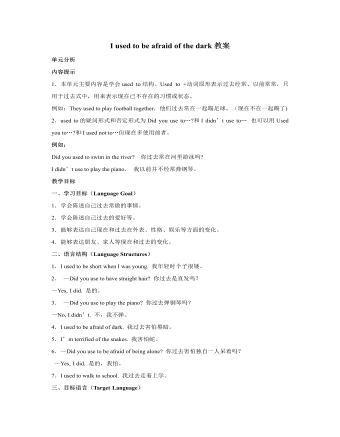
人教版新目标初中英语九年级上册I used to be afraid of the dark教案
- 页数:14页
- |大小:670.50KB
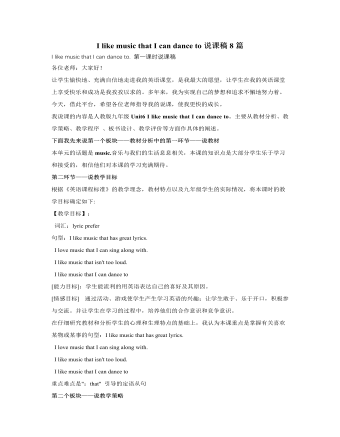
人教版新目标初中英语九年级上册I like music that I can dance to说课稿8篇
- 页数:35页
- |大小:250.00KB
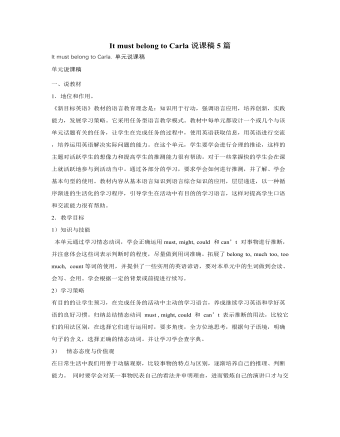
人教版新目标初中英语九年级上册It must belong to Carla说课稿5篇
- 页数:22页
- |大小:93.50KB

人教版新目标初中英语九年级上册Where would you like to visit说课稿8篇
- 页数:33页
- |大小:156.50KB
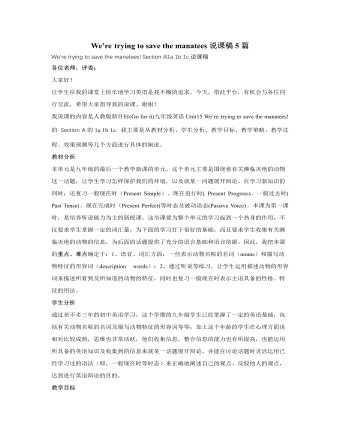
人教版新目标初中英语九年级下册We’re trying to save the manatees说课稿5篇
- 页数:29页
- |大小:154.50KB
热门说课稿
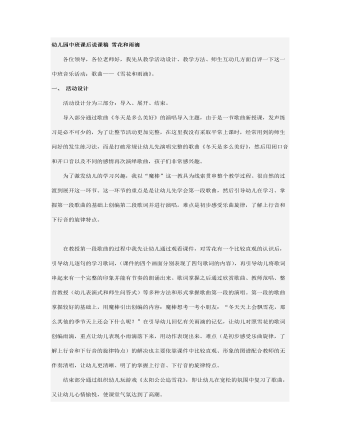
幼儿园中班课后说课稿 雪花和雨滴
- 页数:3页
- |大小:37.00KB
- 说课稿
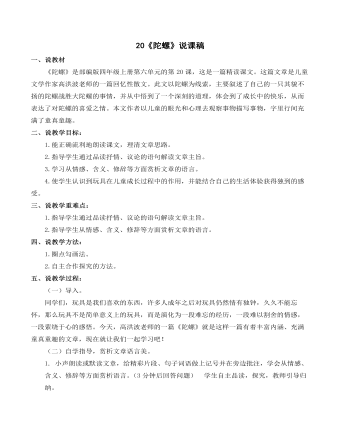
《陀螺》说课稿
- 页数:4页
- |大小:39.00KB
- 说课稿
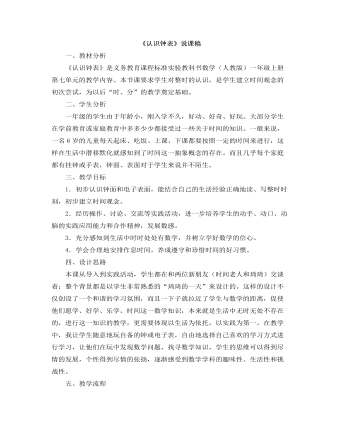
小学数学人教版一年级上册《认识钟表》说课稿
- 页数:4页
- |大小:24.27KB
- 说课稿
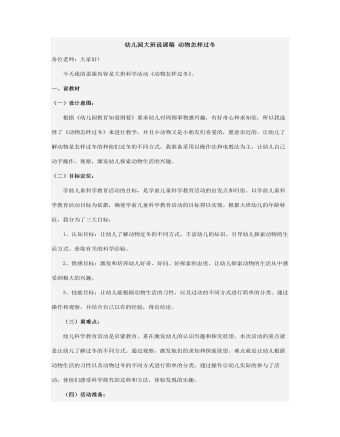
幼儿园大班说课稿 动物怎样过冬
- 页数:3页
- |大小:36.00KB
- 说课稿
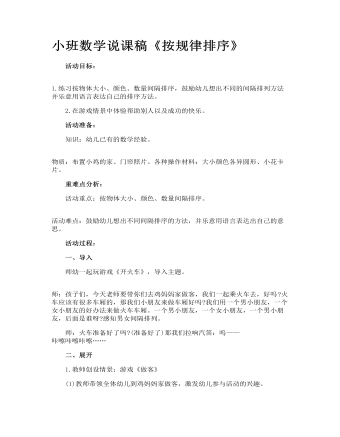
小班数学说课稿《按规律排序》
- 页数:5页
- |大小:92.24KB
- 说课稿
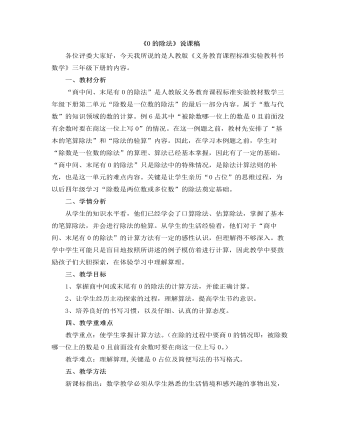
小学数学人教版三年级下册《0的除法》说课稿
- 页数:6页
- |大小:34.92KB
- 说课稿
今日更新
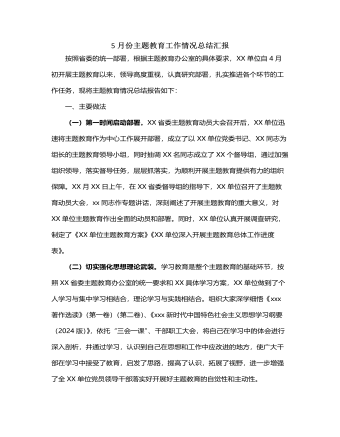
5月份主题教育工作情况总结汇报
- 页数:3页
- |大小:136.87KB

××县招商局2024年上半年工作总结
- 页数:12页
- |大小:142.54KB
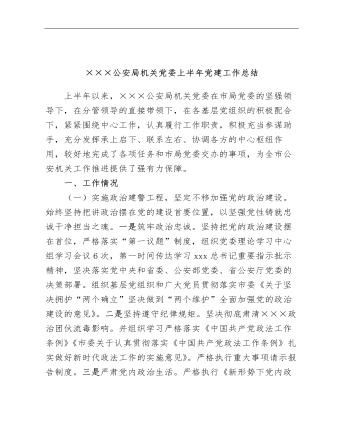
×××公安局机关党委上半年党建工作总结
- 页数:7页
- |大小:186.25KB

《2019—2024年全国党政领导班子建设规划纲要》实施情况的工作总结3800字
- 页数:6页
- |大小:29.16KB
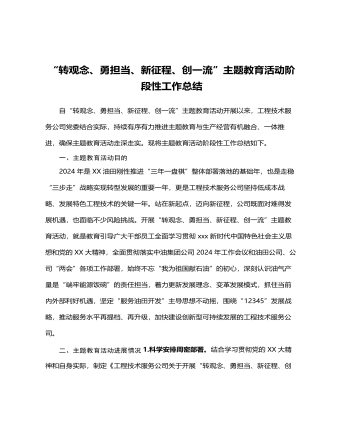
“转观念、勇担当、新征程、创一流”主题教育活动阶段性工作总结
- 页数:3页
- |大小:22.76KB

“四零”承诺服务创建工作总结
- 页数:5页
- |大小:39.83KB
